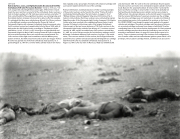Page 214 - 4094-BOOK2
P. 214
LOT 1218
Extremely Rare, Iconic, and Highly Desirable Documented Civil War
Confederate T.W. Cofer Percussion Revolver - Serial no. T, 36 cal., 7 1/2
inch octagon bbl., blue/bright finish, walnut grips. Offered here is hands
down the rarest and most coveted of all the Confederate States revolvers, a
fresh to market example of a T.W. Cofer percussion revolver, serial letter “T”.
Only a small handful of these significant revolvers are surviving today, and
Rock Island Auction Company is honored to be able to offer this example.
It is estimated that there were only between 86 and 140 of these revolvers,
in a few different variations, manufactured by Thomas W. Cofer of
Portsmouth, Virginia, with a known Confederate States Government order
for 82 revolvers received and completed by Cofer by May of 1862, with all
delivered to the 5th Virginia Cavalry, according to “Flayderman’s Guide”
(9th Edition, 10-002, 10-003, 10-004). Union forces occupied Norfolk and
Portsmouth, Virginia in May of 1862, causing Thomas W. Cofer to abandon
his home and shop where these rare revolvers were manufactured. The
Cofer revolvers share slight visual resemblance with the Whitney navy
pattern revolvers, but with a brass frame and an open spur trigger. Thomas
W. Cofer was granted one of the first Confederate States patents, no. 9
granted August 12, 1861 for a revolver with a cylinder made in two halves
that originally used a special type of metallic self-contained cartridge with
a percussion nipple built into the rear of the cartridge.
Relevant information and detailed pictures of other surviving examples
of these Cofer revolvers can be found in the article “Thomas W. Cofer’s
Confederate Patented Revolver” by John Sexton on pages 50-79 of
“Military Antique Collector Magazine” May-June 2023 Volume 2 No. 3.
Sexton’s article indicates that these revolvers were contracted by Captain
Edgar Burroughs of the Chesapeake Light Cavalry, Company I, 5th Virginia
Cavalry, who were recruited in the neighboring Princess Anne County.
On page 78, Sexton’s article shows scans of the original Confederate
States receipts of the two known deliveries of T.W. Cofer revolvers to the
Chesapeake Light Cavalry, with the first delivery of 17 revolvers received
January 18, 1862, and the second delivery of 65 revolvers received May
31, 1862, at a cost of $40 per revolver for each delivery, making a total of
82 known Confederate delivered Cofer revolvers. On page 51, the article
states, “There are two models of Cofer revolver, the first type utilizes the
patent two-piece cylinder and special tapered and flanged brass cartridge
that Thomas W. Cofer was awarded Confederate States patent no. 9,
August 12, 1861. Cofer was born on March 22, 1828, near Smithfield, VA,
and died July 23, 1885. The Cofer is the only Confederate firearms patent.
Only two survivors are known of an estimated ten patent cylinder revolvers
made. Based on the catastrophic failure of serial number 7 and only the
barrel and frame surviving on serial number 1, these were probably not
field worthy and standard percussion cylinder revolvers were made to
fulfill contract. Since known deliveries are five months apart, it is possible
that the January 1862 delivery of seventeen revolvers was the cartridge
type, but since cartridges were not mentioned on receipts, most likely all
were standard percussion. Cofer marked all his revolvers on the frame: ‘T.
W. COFER’S PATENT,’ even though the patent only applied to the patent
cylinder and cartridges. The patent cartridge must have been a failure as
no excavated cartridges are known from camps or battlefields.” Another
contributing factor to the halt on further development of Cofer’s patented
metallic cartridges may have been that the Confederacy was not rich in
material to manufacture them. On page 52, Sexton further states in his
article, “There are sixteen surviving Cofer revolvers of all configurations,
one of smaller caliber and size and unknown ignition system which I call a
prototype, two are patent cartridge models, and thirteen are percussion.”
212


